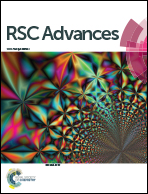Electrophoretic deposited oxide thin films as charge transporting interlayers for solution-processed optoelectronic devices: the case of ZnO nanocrystals†
Abstract
A promising fabrication method of electron transporting interlayers for solution-processed optoelectronic devices by electrophoretic deposition (EPD) of colloidal zinc oxide (ZnO) nanocrystals was demonstrated. A low voltage of 3–5 V and a short deposition time of 40 s at room temperature were found to be sufficient to generate dense and uniform ZnO thin films. The EPD ZnO nanocrystal films were applied as ETLs for inverted organic solar cell and polymer light emitting diodes (PLEDs). By optimizing the EPD processing of ZnO nanocrystal electron transporting layers (ETLs), inverted organic solar cells based on [3,4-b]-thiophene/benzodithiophene (PTB7): [6-6]-phenyl-C71-butyric acid methyl ester (PC71BM) and poly(3-hexylthiophene) (P3HT): [6-6]-phenyl-C61-butyric acid methyl ester (PC61BM) with an average PCE of 8.4% and 4.0% were fabricated. In combination with the PLEDs and flexible devices results, we conclude that the EPD processed ZnO nanocrystal thin films can serve as high quality ETLs for solution-processed optoelectronic devices.


 Please wait while we load your content...
Please wait while we load your content...